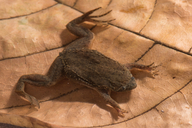|
Pipa myersi Trueb, 1984
Myers' Surinam Toad | family: Pipidae genus: Pipa |
 © 2019 Daniel Vásquez-Restrepo (1 of 1) |
|
|
|
Description Pipa myersi is differentiated from sister species Pipa parva by having a denser collection of dorsal tubercles, a more rounded triangular shape of the snout and mandible, trifurcated digits, the absence of tubercles on the feet, lack of modification to skin around the mouth, ribs attached to transverse processes in adults, free-swimming, barbel-free, aquatic larvae, and lack of free, vestigial transverse processes for the coccyx (Trueb 1984). In life, the dorsum is a dark grayish black and the venter is a grayish yellow. The irises appear pale bronze with brown-black speckling. Newly metamorphosed individuals were observed with a dark gray color with a silvery white peritoneum. When preserved, the dorsum appears reddish to gray-brown with dark brown spotting on hands and limbs. The venter is gray with red-brown spots on pectoral and gular areas concentrated about the mandible (Trueb 1984). No variation in color has yet been documented. Some individuals were found to have six imbricate, presacral vertebrae while others were found to have seven (Trueb 1984). Distribution and Habitat Country distribution from AmphibiaWeb's database: Colombia, Panama
Life History, Abundance, Activity, and Special Behaviors Tadpoles were often observed to be swimming near the surface of vernal pools at night as opposed to daytime, according to Myers’ field notes (Trueb 1984). Trends and Threats Possible reasons for amphibian decline General habitat alteration and loss Comments Based upon character-states among Pipiod frogs, Pipa myersi is a sister species to P. parva with the next closest relative being Pipa arrabali within the Pipa clade and genus Hymenochirus (Cannatella and Treub 1988). The species epithet refers coincidentally to both the preferred habitat of the species, derived from the Old Norse ‘myrr’ meaning bog, swamp, or deep mud and Charles W. Myers, who collected the first known series of adults of the species. Myers’ name itself is derived from the French “myre”, meaning "keeper of the swamp" (Trueb 1984).
References
Cannatella, D.C. and Trueb, L. (1988). ''Evolution of pipoid frogs: intergeneric relationships of the aquatic frog family Pipidae (Anura).'' Zoological Journal of the Linnean Society, 94, 1-38. Duellman, W. E. and Neil Schlager. 2003. Grzimek’s Animal Life Encyclopedia. Volume 6, Amphibians n.p.: Gale, 2003. eBook Collection (EBSCOhost) Solís, F., Roberto Ibáñez, César Jaramillo, Querube Fuenmayor, Manfred Beier 2010. Pipa myersi. In: IUCN 2012. IUCN Red List of Threatened Species. Version 2012.2. Trueb, L. 1984. Description of a new species of Pipa (Anura: Pipidae) from Panama. Herpetologica 40(3): 225-234. Originally submitted by: Monica Ramirez (first posted 2013-07-12) Edited by: Ann T. Chang (2013-07-22) Species Account Citation: AmphibiaWeb 2013 Pipa myersi: Myers' Surinam Toad <https://amphibiaweb.org/species/5232> University of California, Berkeley, CA, USA. Accessed Jun 15, 2025.
Feedback or comments about this page.
Citation: AmphibiaWeb. 2025. <https://amphibiaweb.org> University of California, Berkeley, CA, USA. Accessed 15 Jun 2025. AmphibiaWeb's policy on data use. |


 Map of Life
Map of Life